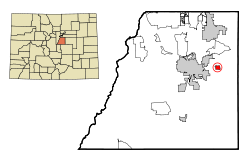|
Franktown, Colorado
Franktown is an unincorporated town, a post office, and a census-designated place (CDP) located in and governed by Douglas County, Colorado, United States. The CDP is a part of the Denver–Aurora–Lakewood, CO Metropolitan Statistical Area. The Franktown post office has the ZIP Code 80116.[4] At the United States Census 2020, the population of the Franktown CDP was 409.[3] HistoryFranktown is named for James Frank Gardner, a prospector who built a cabin 2.9 miles (4.7 km) north of the present location of Franktown in 1859 that became known as Frankstown in the Kansas Territory (also in the extralegal Jefferson Territory.)[5][6] The Territory of Colorado was created on February 28, 1861, and the new territory created Douglas County on November 1, 1861, with Frankstown as the first county seat. On September 8, 1862, the former Russellville post office moved to Frankstown. (Russellville, 1.6 miles (2.6 km) southeast of the present location of Franktown, had been settled by members of the William Greeneberry Russell Party in 1858.) In 1864, the county seat was moved south to California Ranch (at the present location of Franktown), a popular rest stop on the busy Jimmy Camp Trail (which followed Cherry Creek north to Denver.) The residents and post office of Frankstown soon followed to California Ranch which became known as Franktown. The Denver & Rio Grande Railroad reached the new town of Colorado Springs on October 27, 1871, and traffic on the Jimmy Camp Trail rapidly subsided. In 1874, Douglas County moved its county seat from California Ranch to the new town of Castle Rock on the railroad. Despite losing the county seat, Franktown remained a ranching and farming hub, held together by its church, school, grange, and handful of businesses. It never incorporated, and during the twentieth century, no more than a hundred people called it home. Even as suburban sprawl surrounded it at the turn of the millennium, Franktown resisted efforts to develop, maintaining a distinctly rural identity.[7] GrangeFranktown's strong agricultural roots made it a natural fit for The Grange, a cooperative farmers' movement that swept rural America in the mid-1870s. Several dozen chapters formed in Colorado, including the Fonder Grange (founded in 1875) and its successor, Pikes Peak Grange No. 163 (established in Franktown in 1908). Both belonged to the statewide grange organization, which set up credit unions, insurance programs, and other services, and to the national grange association, which pursued long-range political goals. Local chapters more directly affected farmers' lives, with activities such as dances, holiday picnics, and town meetings. These sponsored events helped sparsely populated communities forge a sense of identity. Still active today, Pike's Peak Grange No. 163 in Franktown is listed on the National Register of Historic Places.[8] Castlewood Dam collapseThe Castlewood Dam was built in 1890, about five miles south of Franktown on Cherry Creek. The barrier stored enough water to irrigate 30,000 acres of farmland. The dam began leaking the year it was completed, and was serious enough that a hundred-foot section crumbled in 1897. Although its builders vouched for the structure's integrity, the dam continued to leak sporadically for decades. Finally, on August 3, 1933, Castlewood Dam collapsed, sending a billion-gallon torrent toward Denver. Only two people drowned, thanks to a switchboard operator's life-saving calls, but the flood devastated farms in this area and tore out six bridges in Denver, thirty miles downstream. The dam's remains can still be visited in nearby Castlewood Canyon State Park.[9] Timber industryFrontier travelers often rejoiced upon reaching the timbered ridge just south of Franktown; it was the first woodland they encountered after hundreds of miles on the prairies. Early settlers in Colorado appreciated the forest, too-as a source of building material. Known as "the Pinery," it provided fast-growing Denver and other towns with most of their lumber during the 1860s. Several sawmills buzzed nonstop in and around Franktown, barely able to keep up with the demand. In the early 1870s, the Pinery supplied railroad ties to the Kansas Pacific and Denver & Rio Grande, both of which were laying tracks within twenty-five miles of here. Those routes eventually opened larger forests to exploitation and helped bring down this region's timber industry. By 1880, Franktown's sawmills had gone silent, but they had already left their mark: Pinery lumber built much of early Colorado. GeographyColorado State Highways 83 and 86 intersect in the center of Franktown. SH 83 leads north 9 miles (14 km) to Parker and south 45 miles (72 km) to Colorado Springs, while SH 86 leads east 9 miles (14 km) to Elizabeth and west 7 miles (11 km) to Castle Rock, the Douglas County seat. The Franktown CDP has an area of 1,893 acres (7.661 km2), including 8.9 acres (0.036 km2) of water.[2] DemographicsThe United States Census Bureau initially defined the Franktown CDP for the United States Census 2000.
EducationThe Douglas County School District serves Franktown. See also
References
External links |
|||||||||||||||||||||||||||||||||||||||||||||||||||||||||||||||||||



